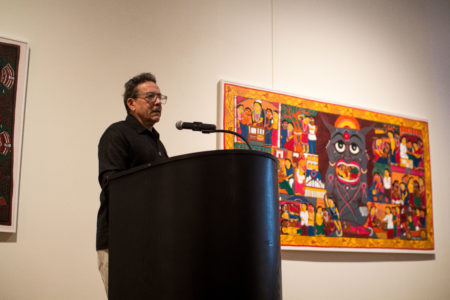By Jackson Schulte
schultej@grinnell.edu
Miami-based artist Edouard Duval-Carrié returned to Grinnell College’s Faulconer Gallery on Oct. 26 to talk about his recent work as both an artist and curator, and his collaborative work with Grinnell students.
Duval-Carrié has been working with Grinnell students in a short course, titled “Visualizing Freedom and Abolition in the New World – A Mixed Media Installation.” The course, according to its description “explores ideas and images of freedom and abolition from the Caribbean to the Midwestern frontier, resulting in a permanent installation for the new HSSC building.”
On his work with Grinnell students, Duval-Carrié said, “We are looking for visual clues and images,” and he mentioned that it will be done in epoxy resin molds. The work is being done in resin because resin resembles amber, which in nature is a sort of natural time capsule, a fitting medium for a building that the College hopes will stick around for generations of Grinnellians.
When talking about his own work, Duval-Carrié focused on his current exhibition, “Metamorphosis,” which is on display at North Miami’s Museum of Contemporary Art. His work there deals with the history of the Caribbean, particularly its involvement with transatlantic slavery and trade.
Duval’s work is far-reaching, and for a contemporary artist, he has a unique focus on the past. When doing research for some of his recent work, he noted that he found, “A lot of the dismantling of sugar plantations had been bought and brought to North Florida,” which Duval-Carrié found through the little-known Federal Bureau of Antiquities.
Duval-Carrié also talked extensively about his interest in history.
“I can’t lose sight of the fact that I’m a contemporary artist, and I can’t just look at history,” he said.
However, Duval-Carrié’s work uses history to perhaps revise the way current viewers think about historical events. For example, he is interested in representing voodoo in his work, which he argues is too influenced by Hollywood.
“Voodoo is a combination of 200-300 tribes bringing together their culture and religion to a dire place,” Duval-Carrié said.
In a few of his paintings, Duval-Carrié draws inspiration from Hudson River School artworks that depict a lush, green and tropical Caribbean landscape. In a bold effort, his paintings that rework the same image are set at night, taking away viewers’ ability to see the Caribbean’s gorgeous landscape. All of this is in an effort to highlight the discrepancies between life in the Caribbean and life in France or the United States.
“They say that Versailles was built with money from the sugar trade.”
Duval-Carrié’s art is not the only way in which he brings gallery-goers face-to-face with Caribbean culture. In the last segment of his talk, he focused on his efforts as a curator, where he works to give Caribbean artists space to exhibit their work at Miami art festivals, such as Art Basel.
“I’m very interested in promoting artists from the Caribbean. So, I introduced a program called Global Caribbean,” Duval-Carrié said. “We’ve supported more than 500 artists.”
He said he was able to do so through money from the Haitian Cultural Arts Alliance, which he supports as a board member and artistic director.
Duval-Carrié’s artistic and curatorial work is important for its emphasis on equality, justice and various identities in the Caribbean. Grinnell should consider itself lucky to have him here on the prairie.

Photo by Reina Shahi






























































